使用雲備份服務將SAP HANADatabase Backup到雲上備份倉庫後,您可以根據需要將備份的資料庫恢複到當前SAP HANA執行個體、同倉庫下其他SAP HANA執行個體或者其他地區的SAP HANA執行個體。
前提條件
已完成SAP HANA備份。更多資訊,請參見備份SAP HANA。
已完成SAP HANA執行個體的備份參數配置。更多資訊,請參見配置備份參數。
注意事項
恢複SAP HANA資料庫期間,雲備份會自動為您停止資料庫。因此,在恢複期間資料庫無法訪問。
同地區下的同執行個體恢複
將備份的資料庫恢複到相同地區下的當前SAP HANA執行個體的操作步驟如下:
在左側導覽列,選擇。
在頂部功能表列的左上方,選擇所在地區。
在SAP HANA備份頁面,選擇SAP HANA实例頁簽。單擊目標執行個體右側的恢复。
在新建恢复任务頁簽,選擇與待恢複的同一個SAP HANA執行個體作為源執行個體進行恢複,單擊下一步。

確認源SAP HANA執行個體及目的SAP HANA執行個體資訊無誤後,選中要恢複目的執行個體的資料庫,單擊下一步。
若源庫被誤刪無法找到,請在SAP HANA中重新建立一個新的同名庫,然後再做恢複。

根據需要選擇不同的恢複方式並完成相關配置項,然後單擊下一步。
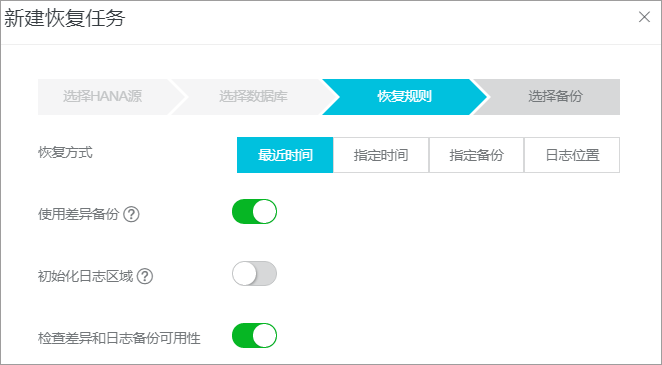
各個配置項說明如下:
恢複方式
說明
配置項
恢複方式
說明
配置項
最近時間
將資料庫恢複到已備份的最近可用狀態
使用差異備份:如果您需要使用差異備份或增量備份執行恢複,請選擇此選項。如果選擇在不使用差異備份或增量備份的情況下執行恢複,則使用記錄備份進行恢複。
初始化日誌地區:如果不想恢複日誌地區中的日誌條目, 請選擇此選項。恢複後,日誌條目將從日誌地區中刪除。
檢查差異和記錄備份可用性:開啟此項後,在恢複開始時,系統會檢查所需的差異備份和記錄備份是否都可用。 如果缺少差異備份或記錄備份,在更改資料之前會停止恢複。
指定時間
將資料庫恢複到特定時間點
使用差異備份:如果您需要使用差異備份或增量備份執行恢複,請選擇此選項。如果選擇在不使用差異備份或增量備份的情況下執行恢複,則使用記錄備份進行恢複。
初始化日誌地區:如果不想恢複日誌地區中的日誌條目, 請選擇此選項。恢複後,日誌條目將從日誌地區中刪除。
檢查差異和記錄備份可用性:開啟此項後,在恢複開始時,系統會檢查所需的差異備份和記錄備份是否都可用。 如果缺少差異備份或記錄備份,在更改資料之前會停止恢複。
恢複到這個時間:選擇需要恢複到的時間點。系統會將資料庫恢複到離這個時間最近的狀態。
指定備份
將資料庫恢複到指定的Database Backup
是否使用Catalog:是否從Catalog中尋找備份。
如果不使用Catalog,需要指定一個備份首碼,雲備份服務會根據備份首碼進行恢複。
日誌位置
將資料庫還原到指定日誌位置
使用差異備份:如果您需要使用差異備份或增量備份執行恢複,請選擇此選項。如果選擇在不使用差異備份或增量備份的情況下執行恢複,則使用記錄備份進行恢複。
初始化日誌地區:如果不想恢複日誌地區中的日誌條目, 請選擇此選項。恢複後,日誌條目將從日誌地區中刪除。
檢查差異和記錄備份可用性:開啟此項後,在恢複開始時,系統會檢查所需的差異備份和記錄備份是否都可用。 如果缺少差異備份或記錄備份,在更改資料之前會停止恢複。
日誌位置:要恢複到的日誌位置。
Volume ID:要恢複的Volume。
選擇用來恢複的任意備份版本,單擊建立。
同地區下的跨執行個體恢複
將備份的資料庫恢複到相同地區且同倉庫下的其他SAP HANA執行個體的操作步驟與同執行個體恢複類似,區別僅在於您需要選擇不同於待恢複的SAP HANA執行個體作為源執行個體進行恢複,並且目標SAP HANA執行個體資料庫必須開啟Catalog備份使用Backint開關。如何開啟Catalog備份使用Backint開關,請參見配置備份參數。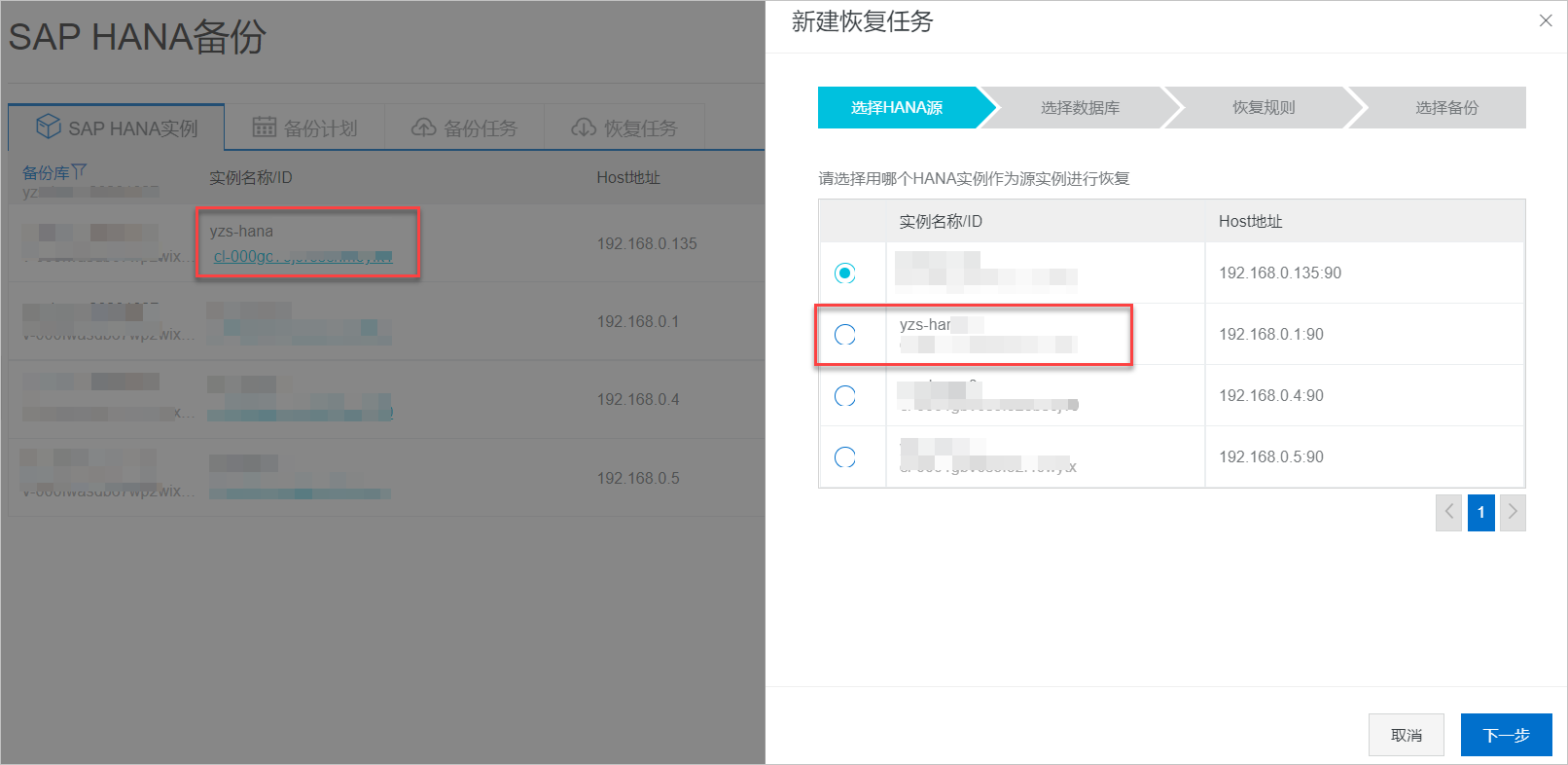
此外,選擇跨執行個體恢複時,需要在確認源執行個體和目的執行個體資訊無誤後,填寫源系統名。源系統名表示需要恢複的來源資料庫名,格式為來源資料庫名@SID。
跨執行個體恢複的其他步驟,請參見同地區下的同執行個體恢複。
跨地區下的跨執行個體恢複
備份庫是雲備份的雲上儲存倉庫,用於儲存備份的資料。您可以根據備份容災的需要,使用異地鏡像備份庫實現跨地區恢複SAP HANA資料庫。
使用異地鏡像備份庫實現跨地區恢複SAP HANA資料庫前,您需要有已建立的鏡像備份庫。有關建立鏡像備份庫的詳情,請參見跨地區備份。
將備份的資料庫恢複到其他地區下的SAP HANA執行個體的操作步驟如下:
在左側導覽列,選擇。
選擇鏡像備份庫所在的地區。
在SAP HANA執行個體頁簽,為指定的SAP HANA執行個體安裝備份用戶端。
備份庫需選擇已建立的鏡像備份庫,且鏡像備份庫名稱帶[COPY]字樣。其他安裝備份用戶端參數配置,請參見註冊SAP HANA執行個體。
找到需要恢複的SAP HANA執行個體,在其右側的操作列表中,單擊恢複。
其他動作步驟與同地區下的跨執行個體恢複類似。
同執行個體下跨資料庫恢複
同執行個體下的跨資料庫恢複,必須藉助SAP HANA Studio工具進行。該工具支援將同一個SAP HANA執行個體下的資料庫恢複到另一個資料庫。
開啟SAP HANA Studio工具,並串連至目標SAP HANA執行個體。
按右鍵待恢複的資料庫執行個體,選擇。
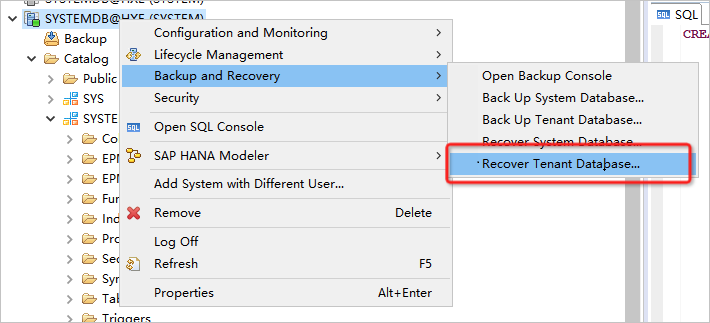
選擇TenantDB。

在Specify Recovery Type視窗,單擊Recover the database to a specific data backup。
在Specify Backup Location視窗,配置以下參數。
單擊Recover using the backup catalog
單擊Search for the backup catalog in Backint only
選擇Backint System Copy
在Source System中填入DBNAME@SID。
其中,DBNAME為待恢複的備份資料庫名稱,SID為當前資料庫執行個體ID。
按照介面嚮導提示,停止資料庫,並選擇需要恢複的備份。
如果Backups列表沒有相應的備份記錄,則表明您沒有開啟Catalog備份使用Backint開關。如何開啟Catalog備份使用Backint開關,請參見配置備份參數。

確認恢複設定,單擊Finish。
使用Prefix方式恢複SAP HANA
在以下情境,您可以通過Prefix方式恢複SAP HANA執行個體。
SAP HANA資料庫執行個體停止後,Cloud Backup無法從catalog中擷取歷史備份導致恢複SAP HANA執行個體失敗。
跨執行個體恢複SAP HANA後,由於catalog被覆蓋,導致Cloud Backup無法恢複當前資料庫舊的備份。
從catalog中擷取歷史備份的Prefix首碼。
通過SSH方式登入SAP HANA執行個體。
執行以下命令擷取歷史備份的首碼。
其中SID、InstanceNumber、hostname、DBNAME需要替換為您SAP HANA執行個體的配置項。
cat /usr/sap/{SID}/HDB{InstanceNumber}/{hostname}/trace/DB_{DBNAME}/backup.log | grep COMPLETE_DATA_BACKUP例如,您可以通過
cat /usr/sap/HXE/HDB90/yzs-hana-daily/trace/DB_HXE/backup.log | grep COMPLETE_DATA_BACKUP命令擷取Prefix首碼。2022-06-02T20:38:51+08:00 P0007269 181246cfc22 INFO BACKUP command: BACKUP DATA FOR HXE USING BACKINT ('/usr/sap/HXE/SYS/global/hdb/backint/DB_HXE/COMPLETE_DATA_BACKUP_2022_06_02_20_38') ASYNCHRONOUS 2022-06-02T20:38:51+08:00 P0007269 181246cfc22 INFO BACKUP to backint: /usr/sap/HXE/SYS/global/hdb/backint/DB_HXE/COMPLETE_DATA_BACKUP_2022_06_02_20_38_databackup_0_1 2022-06-02T20:38:51+08:00 P0007269 181246cfc22 INFO BACKUP to backint: /usr/sap/HXE/SYS/global/hdb/backint/DB_HXE/COMPLETE_DATA_BACKUP_2022_06_02_20_38_databackup_2_1 2022-06-02T21:38:51+08:00 P0007269 18124a3ea82 INFO BACKUP command: BACKUP DATA FOR HXE USING BACKINT ('/usr/sap/HXE/SYS/global/hdb/backint/DB_HXE/COMPLETE_DATA_BACKUP_2022_06_02_21_38') ASYNCHRONOUS 2022-06-02T21:38:51+08:00 P0007269 18124a3ea82 INFO BACKUP to backint: /usr/sap/HXE/SYS/global/hdb/backint/DB_HXE/COMPLETE_DATA_BACKUP_2022_06_02_21_38_databackup_0_1 2022-06-02T21:38:51+08:00 P0007269 18124a3ea82 INFO BACKUP to backint: /usr/sap/HXE/SYS/global/hdb/backint/DB_HXE/COMPLETE_DATA_BACKUP_2022_06_02_21_38_databackup_2_1其中
COMPLETE_DATA_BACKUP_2022_06_02_20_38部分即為首碼。
在雲備份控制台,以Prefix方式建立恢複任務。
在左側導覽列,選擇。
在頂部功能表列的左上方,選擇所在地區。
在SAP HANA備份頁面,單擊目標執行個體右側的恢複。
在建立恢複任務頁簽,選擇與待恢複的同一個SAP HANA執行個體作為源執行個體進行恢複,單擊下一步。

確認源SAP HANA執行個體及目的SAP HANA執行個體資訊無誤後,選中要恢複目的執行個體的資料庫,單擊下一步。
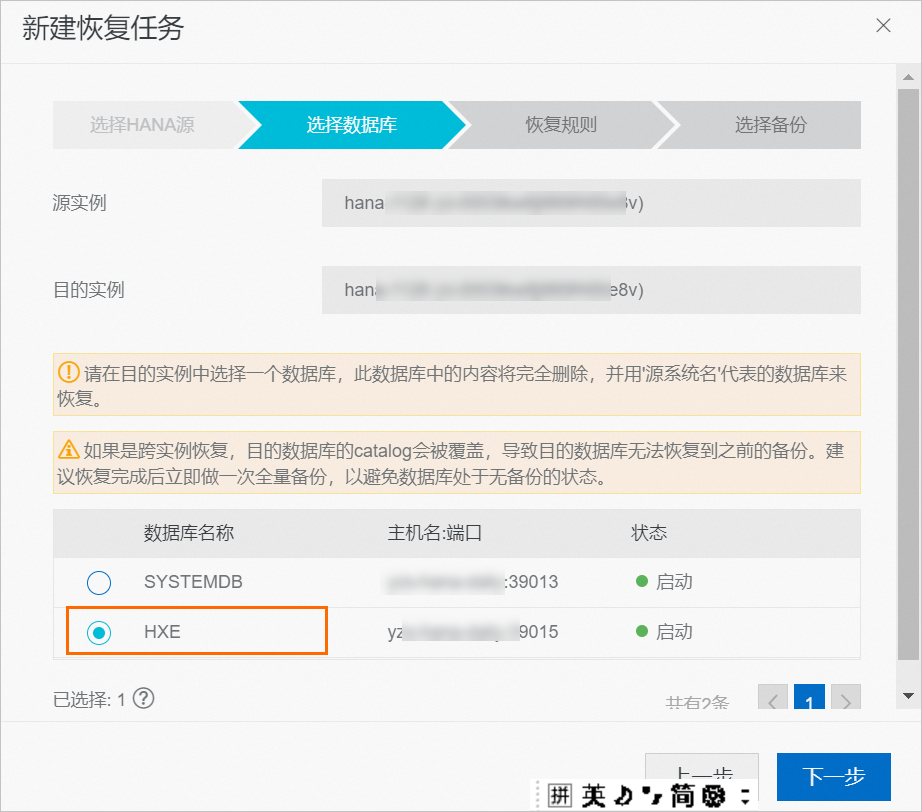
在恢複規則頁簽,按照以下參數配置,然後單擊下一步。
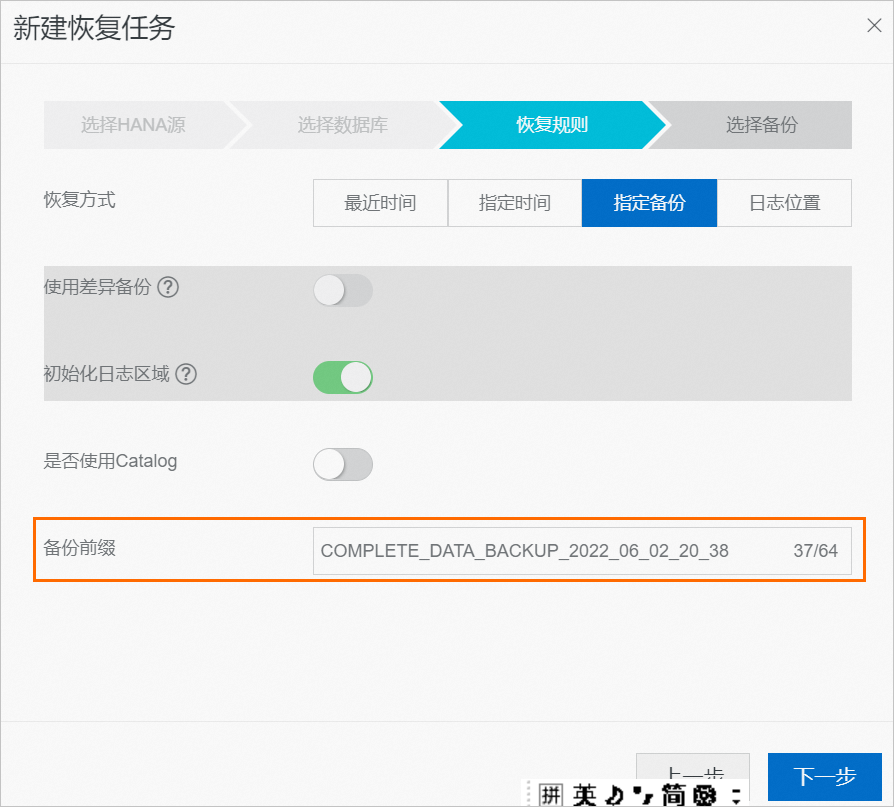
恢複方式
說明
配置項
恢複方式
說明
配置項
恢複方式
配置恢複方式。
選擇指定備份。
是否使用Catalog
是否從Catalog中尋找備份。
關閉是否使用Catalog開關。
備份首碼
指定一個備份首碼,雲備份服務會根據備份首碼進行恢複。
取值為步驟1擷取的首碼。例如
COMPLETE_DATA_BACKUP_2022_06_02_20_38。
選擇用來恢複的任意備份版本,單擊建立。
更多操作
您可以查看恢複任務的狀態,或取消正在執行的恢複任務。具體操作如下:
在左側導覽列,選擇備份。
在SAP HANA備份頁面,單擊恢複任務。
在恢複工作清單中查看恢複任務的狀態。
如果需要消進行中中的恢複任務,在恢複任務右側,單擊取消。





















